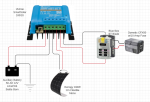I'm adding a 50AH LiFePO4 auxiliary battery to my vehicle to power my Dometic CFX 50, LED camp lights at night, charge mobile devices, and such.
I'm going to use the Renogy RBC50D1S to charge the battery from my alternator and solar panel(s).
This is the diagram I've put together so far, do any "experts" see any problems or am I good to go? (Thanks in Advance!)
Also, any problems with just cutting off the 12v lighter plug and putting cables directly to the Blue Sea ST Blade? I'm guessing not, there will be a 10Amp fuse and the distance is not longer than the OEM cable.

I'm going to use the Renogy RBC50D1S to charge the battery from my alternator and solar panel(s).
This is the diagram I've put together so far, do any "experts" see any problems or am I good to go? (Thanks in Advance!)
Also, any problems with just cutting off the 12v lighter plug and putting cables directly to the Blue Sea ST Blade? I'm guessing not, there will be a 10Amp fuse and the distance is not longer than the OEM cable.


